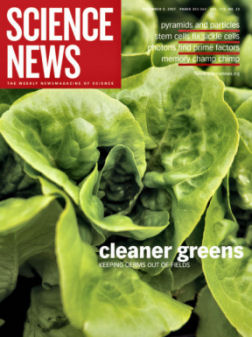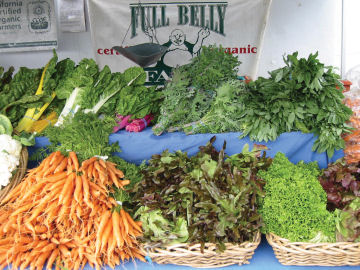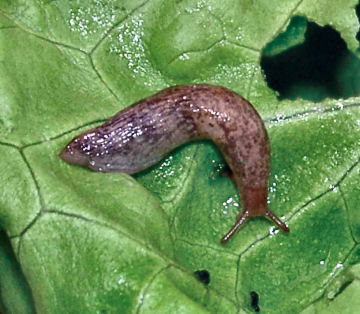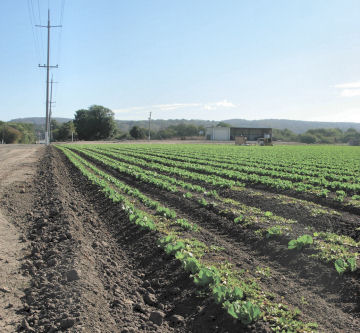Lettuce Liability
Programs to keep salads germfree raise wildlife and conservation concerns
Little more than a year ago, supermarkets from coast to coast stripped fresh spinach from produce aisles as a food-poisoning outbreak swept the nation. From mid-August through September 2006, virulent bacterial infections sickened at least 204 spinach consumers. Five died and 30 others suffered acute kidney failure.




Among more than 3,500 genetically unique strains of Escherichia coli O157:H7, microbiologists ultimately linked all of those spinach poisonings to a single strain. Uncertainty over where that germ entered the salad-supply chain prompted the biggest food recall in history, with multimillion dollar losses. Eventually, federal and state government scientists traced the national outbreak to a single California farm.
Now, as insurance companies have begun paying out huge settlements to victims and their families, food-handling practices by one California farm, the company that processed the spinach, and the conglomerate that helped market and distribute the greens have all come under scrutiny for their potential liability.
Although the rate of disease outbreaks may not be increasing, large-scale food distribution has helped increase the ability to track an infection back to its source, making sellers a growing target for lawsuits.
The outbreak of one germ on one farm managed to shake up California’s entire $14.6 billion-a-year produce industry, which supplies roughly two-thirds of U.S. salad greens. Within a month, that industry began creating a new program to strengthen what it perceived to be a particularly vulnerable link in the supply chain: the farm. The resulting Leafy Greens Marketing Agreement rolled out on July 23.
Some 118 shippers, processors, and distributors, representing virtually all California-grown greens, have signed on to the agreement. Farms that sell salad greens to any of those companies must adopt dozens of new food-safety rules. Because livestock and wildlife serve as reservoirs of E. coli and other harmful bacteria, most of the rules focus on keeping animals and animal wastes away from crop fields.
Some rules limit how close farmers may plant crops to grazing livestock, composting manure, surface waters, and non-crop vegetation. Others require frequent germ testing of irrigation water and strict sanitation practices for farmworkers and tools.
While no one argues against improved germ control, conservation agencies and environmental groups say that the new Leafy Greens rules are triggering changes that will erode hard-won gains in protecting wildlife and its habitat. For example, the rules encourage some growers to eliminate erosion-controlling hedgerows that might harbor disease-carrying animals and to keep out deer by erecting tall fencing that may block wildlife-migration corridors.
Judith Redmond, a co-owner of the certified-organic Full Belly Farm near Sacramento, Calif., told Science News that the Leafy Greens rules threaten to put farming at odds with environmental goals. For the past 2 decades, she says, “a vanguard of farmers has been trying to figure out how to farm with nature [and] be good environmental stewards.”
Although participation in the new initiative is ostensibly voluntary, “the marketplace is such that if you don’t sign on, no one’s going to buy your product,” says Joe Pezzini, a vice president of Ocean Mist Farms in Castroville, Calif., and chairman of the Leafy Greens advisory board. Even the Canadian Food Inspection Agency recently announced that it will allow importation of California salad greens only from handlers that have signed on to the Leafy Greens program.
California farmers now face a tough choice: Adopt costly, environmentally damaging changes in order to sell to members of the Leafy Greens agreement or risk losing a major market share.
And the issue is already starting to spread to other states. On Oct. 2, Arizona’s food industry adopted a similar Leafy Greens program. Two days later, the U.S. Department of Agriculture proposed establishing a national program modeled on California companies’ Leafy Greens initiative.
Audit brigades
Even before the 2006 spinach recall, companies that grow and market lettuce and other leafy produce had developed safety guidelines such as the repeated rinsing of leaves, frequent disinfection of hands and tools that touch the greens, and tracking of batches of greens so that the source of an outbreak can be quarantined. Yet such measures didn’t prevent last year’s outbreak from sickening people in at least 26 states.
“Because of all that happened with the spinach outbreak, for the first time the industry was ready to say: ‘We need a set of mandatory standards,'” Pezzini recalls.
With the Leafy Greens agreement, what were formerly guidelines for good farm practices have suddenly become rules. USDA-trained inspectors now audit farms to enforce the industry’s new self-regulation. Perceived violations can result in would-be buyers rejecting all or part of a harvest.
Most affected farmers were already used to scrutiny by outside auditors, observes Melanie Beretti of the Monterey County (Calif.) Resource Conservation District in Salinas. Every company that moves or markets farm commodities can inspect its growers’ agricultural practices, she says.
“If you’re a grower selling to three different shippers and two different [food] processors—and each of them sells to a couple different retailers—you might have a dozen individuals come out to conduct food-safety audits of your farm,” she explains.
However, in the interests of improving food safety, inspections have become increasingly stringent and interpretations of what constitutes good practices vary among individual auditors, Beretti says.
Animal unfriendly
Under the new Leafy Greens rules, more than 400 feet must separate the edges of fields from livestock waste and composting manure. Livestock may not graze within 30 feet of a field and untreated manure must be stored at least 200 feet from wells and no less than 100 feet from surface waters providing irrigation. During the growing season, farmers must test irrigation water monthly for E. coli and other pathogens and share lab findings with auditors. Growers must also keep a 2-year record listing any possible field intrusion by pigs, deer, cattle, goats, sheep, and other possible E. coli carriers.
Many companies that have signed the Leafy Greens agreement ask growers not only to follow these rules but also to exceed them dramatically. For example, the rules recommend installing fences where deer or pigs frequently pass through fields, but some auditors have begun telling farmers that they need to install tall chain-link fences even where deer intrusion is rare, notes Full Belly Farm’s Redmond.
This summer, the Monterey Resource Conservation District surveyed some 200 farms in and around the Salinas Valley and California’s central coast, where most of California’s leafy greens are grown. The results, says Beretti, show “it’s not just that growers feel they’re caught between the conflicting demands of food safety and the environment; we have statistically defensible evidence that many really are caught in the middle.”
For instance, 7 percent of farmers had removed ponds in response to demands from auditors. Although the Leafy Greens rules don’t require pond removal, some auditors have said that ponds could harbor disease-causing amphibians and waterfowl.
In addition, 32 percent of surveyed growers were instructed by auditors to remove non-crop vegetation, such as hedgerows. At auditors’ request, half of surveyed growers said they had surrounded fields with deep, bare-ground buffers, 40 percent had installed fencing to keep out wildlife, 40 percent had installed wildlife traps, and at least 50 percent had installed poison bait stations to kill rodents.
Where feces or other signs of wildlife appear, Leafy Greens rules instruct farmers not to harvest crops within a radius of at least 5 feet. “I had one farmer tell me that for one company he grows for, if there’s been evidence of wildlife intrusion, he must draw a 20-foot radius around that spot; everything inside it is nonharvestable,” Beretti says.
Trevor Suslow, a plant pathologist at the University of California, Davis, has heard similar anecdotes. When an auditor is visiting a field and finds a single frog or hoofprint, that inspector may “reject 10 acres of product,” he says.
Hoofprints, in particular, have become a hot-button issue, since wild pigs were found carrying the germ responsible for the 2006 spinach outbreak. Of 40 pigs examined, colons of two hosted last year’s outbreak strain of E. coli, notes Andrew G. Gordus of the California Department of Fish and Game in Fresno. Five of 47 samples of feral-pig scat also carried that version of E. coli.
On rare occasions, wild-goose feces are known to host E. coli O157:H7. Of approximately 1,000 samples tested, however, “only one was positive,” says Gordus.
Suspicions that deer might also host the germ prompted Gordus’ team, together with colleagues from UC-Davis and the federal government, to launch a study in August inspecting colons from deer caught during the local 6-week hunting season. Hunters in the Salinas region brought in colons from only 27—too few to be statistically significant, but none carried E. coli.
Immune to fences
Even unreasonably high safety standards aren’t foolproof. The Leafy Greens rules focus on efforts to curb field intrusions by livestock, large wildlife, and their wastes, but new research indicates that germs may be spread by animals that could move under, over, or through any fencing. Furthermore, E. coli and other food-poisoning germs may colonize field crops even without animal transmission (SN: 10/20/07, p. 250).
Last year, slugs in a Scottish pasture were found harboring the same strain of E. coli O157:H7 that nearby infected sheep were excreting. The incidence was low. Of 33 batches of slugs, each containing 15 animals, only one batch tested positive, Emma L. Sproston and her colleagues at the University of Aberdeen reported in the January 2006 Applied and Environmental Microbiology.
To confirm the findings, Sproston placed slugs on a piece of moist paper seeded with a nontoxic form of E. coli and allowed the animals to slime their way across its surface. Afterward, the slugs hosted E. coli for 2 weeks. Once excreted, the germs remained alive in the slugs’ feces for another 3 weeks.
Sproston says, “I’ve also found a few slugs carrying Campylobacter,” food-poisoning bacteria normally associated with chickens (SN: 8/7/04, p. 85).
It seems reasonable, she concludes, that germs “could end up in your salad” if slugs passed through feces from infected livestock or wild animals and then crawled onto lettuce. Alternatively, she notes, a bird might dine on an infected slug and spread ingested germs onto field crops via its droppings.
Sproston’s latest studies of a farm with cattle and sheep indicate flies, too, can host and presumably transmit E. coli.
Even American bullfrogs can be carriers. In one experiment, scientists put E. coli O157:H7 into the mouths of two dozen bullfrog tadpoles shortly before they were due to metamorphose, then left them to mature in stagnant water. More than half showed evidence of infection lasting at least 2 weeks, reported Debra L. Miller of the University of Georgia in Tifton, and her colleagues in the June Applied and Environmental Microbiology.
Because the dose administered to these frogs was large, Miller says, “the only thing we know for sure is that if they ingest [the E. coli], it can stay alive in them long enough to come out the other end.” If this happens in the wild, her team argues, frogs might hop between ponds and contaminate water used for irrigation or for drinking by other animals.
Farmers’ liability
When a product causes illness, U.S. law renders businesses strictly liable, which means they’re responsible even if they were unaware that their goods were tainted. For farmers, however, a different standard applies, explains attorney Jeffrey Gilles, who advises Salinas Valley farmers and food processors on food-safety issues. Traditionally, farmers have become liable for selling tainted products only if they exhibited negligence.
In recent years, however, companies that buy crops have increasingly been writing contracts that require a farmer to indemnify them for any financial hit that may result from the grower passing along tainted food.
In hopes of catching any tainted foods early, processors are starting to require frequent spot checks for bacterial contamination of crops in the field, immediately after harvest, and at every step into and through a food-packing facility, says Gilles.
As Salinas Valley companies gradually adopt such measures, Gilles expects that by next spring’s harvest “virtually 100 percent of the processors will require this … and eventually that every processor in California will.” The goal is to identify contamination before it enters the retail market, so that any tainted goods can be culled from the supply chain long before they can reach consumers.
The discouraging news, says University of California’s Suslow, is that this new field testing “is showing that the extent of contamination in fields—although low—is unfortunately higher than we ever could have known.” Neither farmers nor food processors are sharing hard numbers publicly, but they are routinely turning up “a low, but certainly detectable, level of pathogens,” he says.
“Since we’re never going to have zero risk” of crop contamination, Beretti says, the industry, including growers, must embrace science to identify what bacterial quantities are dangerous and then learn to surgically rout them. And this must be accomplished, she argues, by neither “sacrificing food safety for the environment nor compromising the environment for food safety.”






